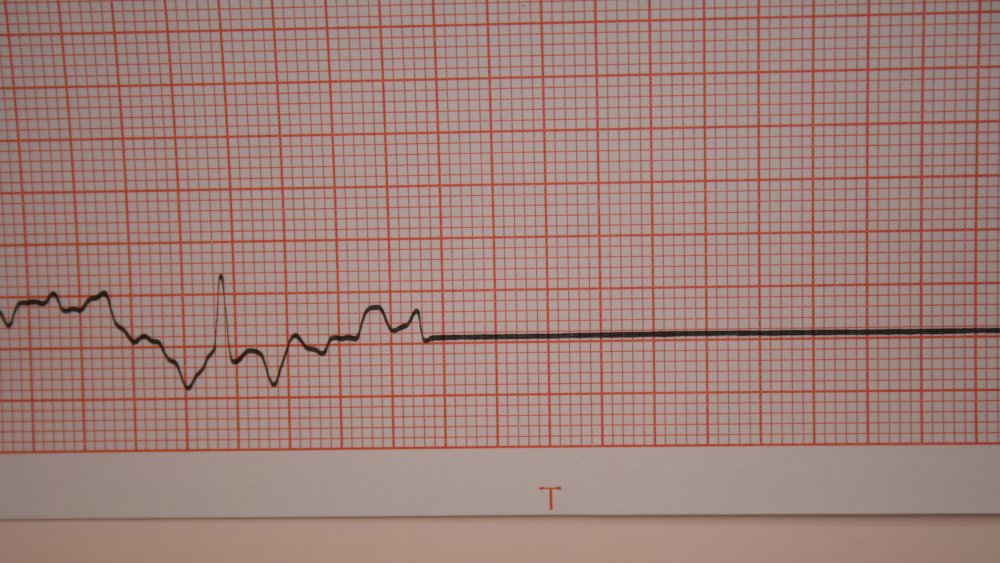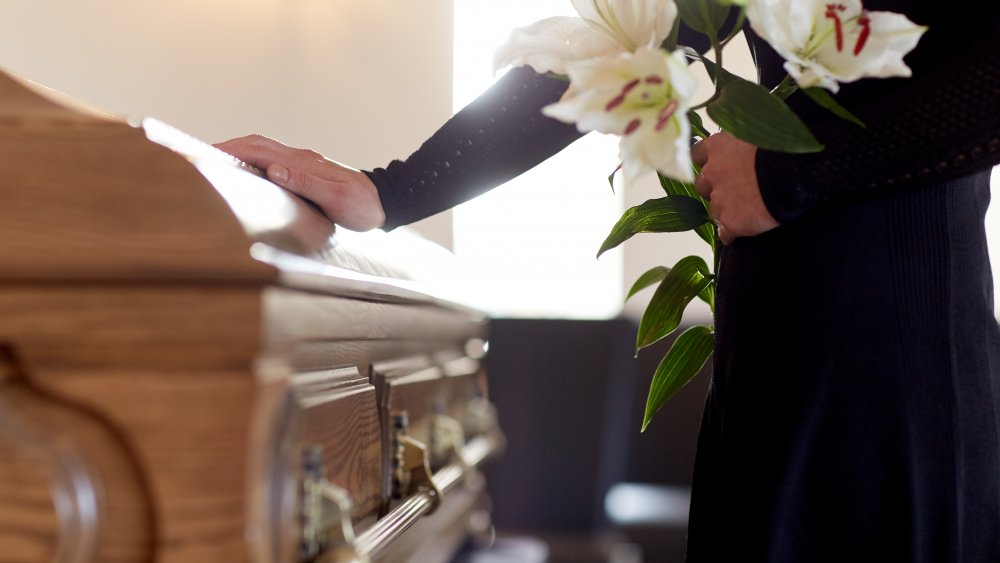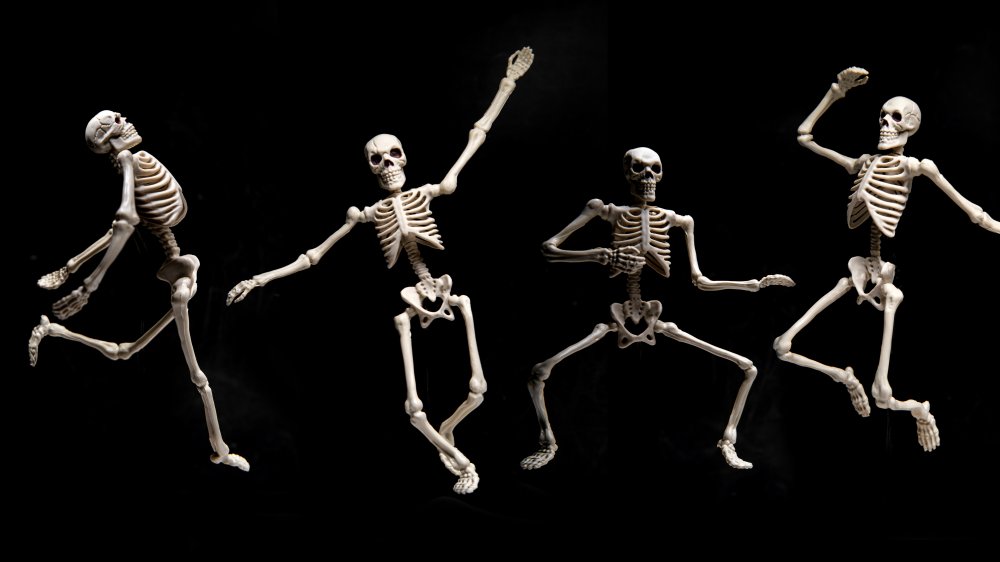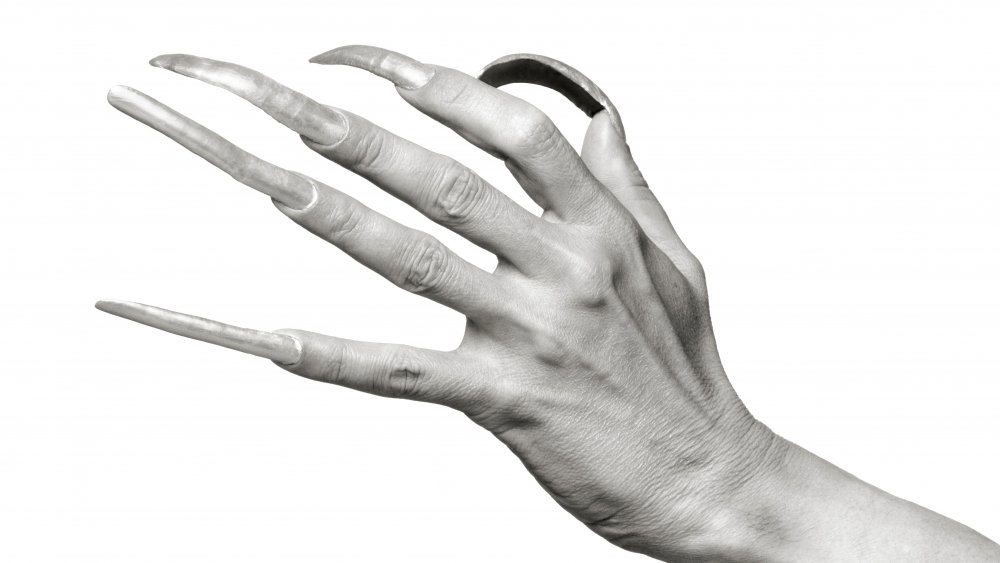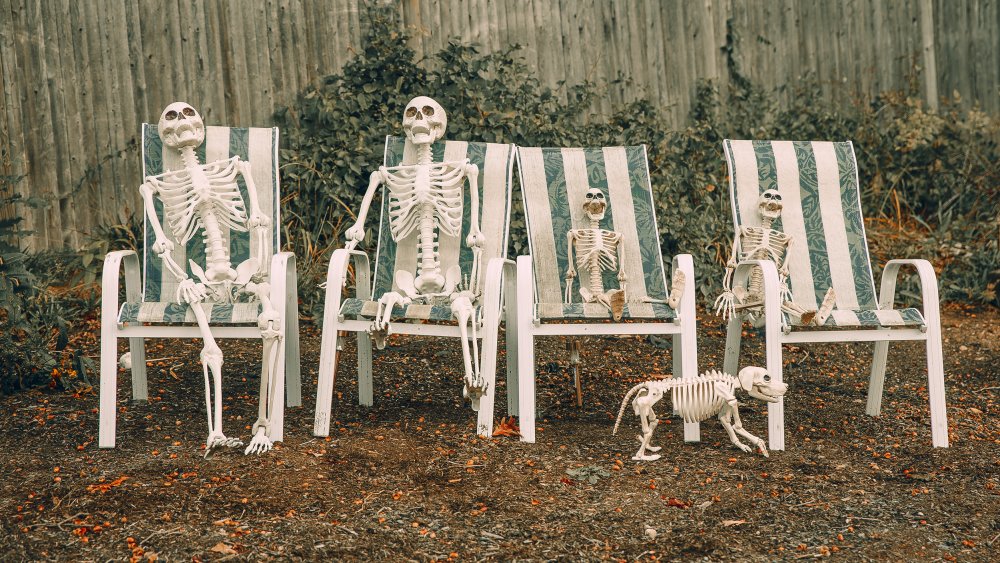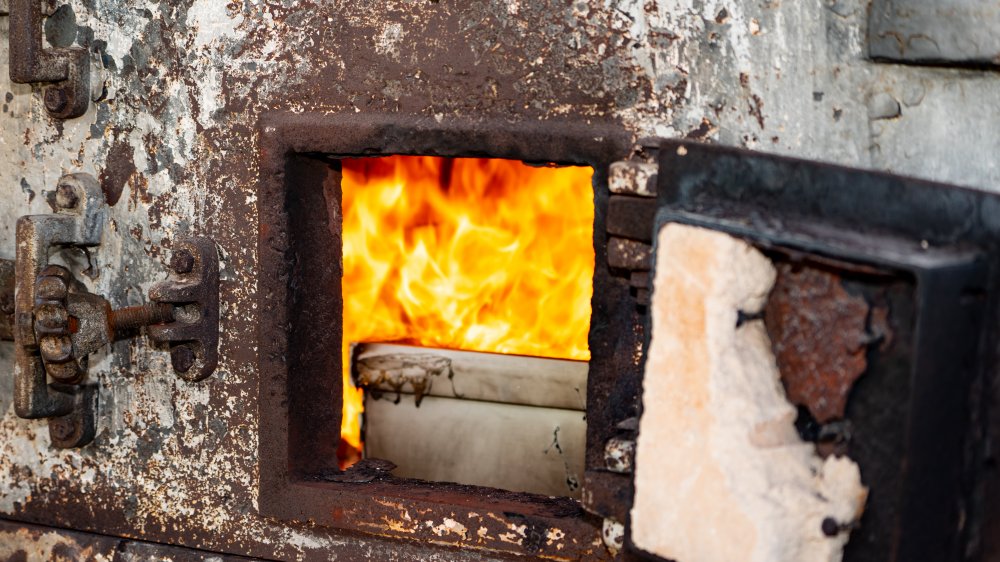Here's What It's Like To Die
There is one thing that every person has in common, and that's death. Regardless of how well you take care of your body, and the efforts put forth in attempt to prolong your life, one day you will most assuredly pass away, and there's absolutely nothing that can be done about it. The mysteries surrounding death are both a point of fear and fascination for most people. The certainty that the day will one day come is a given, but no one can know exactly when, or how, it will happen.
A 2018 BBC article breaks down how life expectancy has increased exponentially over the last few decades. In the 1960s, the average person tapped out by their early 50s. Presently, the average expiration date is closer to the late-70s, according to data from the Centers for Disease Control and Prevention's National Center for Health Statistics. The most common causes of death have also changed throughout the years. A visual chart presented by Cleveland Clinic shows that in the early 1900s most deaths could be attributed to pneumonia and flu, while in 2015, heart disease and cancer were the biggest killers.
Death can come any number of ways, but it will come, and what happens then? Read on, if you're brave enough (and have a strong enough stomach) to see exactly what happens to the body during, and just after, the end of life.
A dying person feels cold for a reason
When a person starts dying, their circulation reduces so it can focus primarily on the body's internal organs, according to a post by Medical News Today. This process reduces blood flow to the hands, legs, and feet, which is why a person nearing the end of their life often feels cold to the touch, or might complain of feeling cold themselves.
This change in blood flow can also cause the dying person's skin to appear yellow, or waxen. The site Live With Care reports that some will also develop what's referred to as "mottling," which is a purple or pink pattern forming on the skin. There's nothing that can be done to stop these changes to the body, but attempts to make the person more comfortable can be made by adjusting the room's temperature, or providing extra blankets. Electric blankets are not a recommended remedy, however. The site Senior Safety Advice warns that elderly people have "impaired temperature receptors in their skin or a delayed ability to realize they have gotten overheated," which can lead to burns.
You're not just seeing things ... you're dying
When approaching death, a person's brain starts to shut down in certain areas, to focus on only the most necessary functions, much in the same way the rest of the body does. David Hovda, director of the UCLA Brain Injury Research Center, supplied this info for a 2016 Atlantic article, and went on to say that "as the brain begins to change and start to die, different parts become excited, and one of the parts that becomes excited is the visual system ... so that's where people begin to see light."
Jimo Borjigin, a neuroscientist at the University of Michigan who also contributed to the Atlantic article explains that the sudden release of neurochemicals in a brain that is beginning to shut down can cause a person to have "amazing experiences." Jennie Dear, the writer of the article, says that one time during her mother's last few days of life, she got a dreamy look on her face and began raising her arms and working her hands in the air. When Dear asked what she was doing, her mom replied "putting things away."
Chaplain Ann O'Shea from Crossroads Hospice & Palliative Care says she's been with many patients who have claimed to see loved ones who weren't actually there. Crossroads Nurse Carolyn Quach-Huynh adds that patients will also have dreams of loved ones during their end days, or smell a familiar smell such as cigars or a certain perfume.
Death can be slow ... until it's not
A natural death can seem like it's dragging out forever, because there's a lot of dying that takes place before a person is actually dead. A 2016 article in The Atlantic paints a vivid picture of what its like to sit at the bedside of someone going through the last years, months, and days of their lives. The author, Jennie Dear, wrote about her experience caring for her mother during the final stages of breast cancer, and was there in her family home when the hospice nurse on duty asked her mom if she wanted to know what will happen to her body when it started to shut down.
After what she heard from her mother's nurse, and further research compiled from medical professionals, Dear learned that until about 100 years ago most deaths happened quickly, because there were no medical measures set in place to properly care for patients. Due to modern advancements in medicine, death can be prolonged for quite some time.
James Hallenbeck, a palliative-care specialist at Stanford University writes about a stage called "active dying" in his book Palliative Care Perspectives. Active dying is described as a final, rapid slide that happens in roughly the last few days of life. "First hunger and then thirst are lost," Hallenbeck writes. "Speech is lost next, followed by vision. The last senses to go are usually hearing and touch."
There are two types of death
In standard medical terms, there are two ways that a person's death is determined. The book, Nursing Made Incredibly Easy explains that the most commonly accepted form of death is cardiac death, which is the "absence of the heart contracting and pumping blood due to a disturbance in its electrical activity." The second, less common, is brain death, which is defined as "the irreversible absence of all brain activity." Once a person becomes brain dead, the heart can continue pumping, when hooked up to medical equipment, but would not be able to do so on its own.
Before the invention of ventilators and medications that help keep the body's functions active, there was no need to factor in such a thing as brain death. In earlier medical days, "patients with no brain function quickly succumbed to cardiac arrest."
This presents an often difficult situation, both for family members, as well as medical professionals who have to make the call whether to keep a person who's been diagnosed as brain dead on a ventilator, or to pull the support and let their heart follow the brain to death. If death is no longer a single, specific moment in time, everything gets complicated.
You might hear your own death being announced
As if the process of dying isn't grim enough, there is scientific evidence that points to the fact that a person's brain can sometimes remain active after they pass away, long enough to hear their own time of death announced.
Dr. Sam Parnia, director of critical care and resuscitation research at NYU Langone School of Medicine in New York City gathered together a team to study a selection of people who briefly died after suffering cardiac arrest, but were revived. In a 2017 Independent article, it's explained that some of the patients he and his team studied claim to have heard full conversations, and even viewed the room they were in, after their death had been called by medical professionals. When their claims were presented to the medical teams present at the time, the details of what they experienced were verified.
Death is most commonly called at the point of ones heart stopping, which is referred to as cardiac death, but even after the heart stops there is often a surge of brain activity that could cause a person to experience brief moments of near clarity. So that's ... something super creepy to look forward to.
The mysterious 21 grams
A Massachusetts doctor named Duncan MacDougall published a study in 1907 on a the results of experiments he'd conducted to determine if the human soul has weight. In a 2015 Discover article, it's explained that during these experiments he noted each patient's time of death, their time spent on their death bed, and changes in weight caused by the loss of body fluids and gasses. For each and every patient there were 21 grams left unaccounted for, which he concluded to be the weight of the soul.
Although this was a theory that dates all the way back to the beginning of the 20th century, it's one that is widely believed in varying degrees to this day. The popular debunking site Snopes took a look at the 21 grams mystery in 2005 and determined that it's half true. Yes, MacDougall did perform these tests, but his methods were flawed and demonstrated nothing credible that could be tied directly to the weight loss having anything to do with the soul, which many people don't believe exists in the first place.
Following MacDougall's experiment, physician Augustus P. Clarke countered that a rise in body temperature at death, caused by the lungs no longer cooling blood, could cause a rise in sweating which could account for the missing 21 grams. Robert Stern, a pathologist at the University of California, San Francisco, told the Guardian in 2004, "I've been dealing with death for 45 years and I can say with some confidence there's nothing in it," regarding the 21 grams theory.
Noises from beyond the grave
Caleb Wilde, author of the book Confessions of a Funeral Director, has firsthand experience with more corpse scenarios than most, to be sure. In his book he reveals that when a corpse is moved, if there's air trapped in its lungs, the body can make a variety of startling sounds like moans and gasps. Even worse, some of the trapped air can escape from the other end, resulting in untimely corpse farts. Not something you wanna hear while preparing for a viewing or funeral service.
A different kind of noise can be heard coming from a body, which takes place closer to their actual time of death. This noise, or combination of noises, is commonly referred to as a "death rattle," which occurs when a body is no longer capable of swallowing, which causes secretions to build up in the respiratory tract. According to Medical News Today, a death rattle might sound like a crackling, wet noise, or a moan, or even a snore, all of which can become amplified if the person is still breathing. If this noise is heard, death is often right around the corner.
If you gotta go, you gotta go
It's possible for a person to "live fast, die young, leave a good-looking corpse," as per the infamous quote by Chicago writer Willard Motley, but not for very long. At the moment of death, a person's body enters a state called primary flaccidity, according to Very Well Health. During this state, the part of the brain that controls muscle control shuts down, and all remaining feces and urine drain freely. Gas exiting the body helps to push the waste through, which is just one of many unpleasant truths about death.
A video posted in 2012 on the popular YouTube channel, Ask A Mortician, describes that people who work with dead bodies such as doctors, nurses, and morticians, are all very aware of the possibility of coming into contact with urine and feces when handling a corpse, and while it's certainly not a part of the job that anyone looks forward to, it "is what it is." The video also touches upon the fact that when a mortician is preparing a body for viewing, they have to prevent against anal leakage by either putting a diaper on the corpse, or by inserting a device called an AV Plug into the anus – not to be confused with the AV Cord you use to hook up a stereo, which is an altogether different, and entirely more enjoyable device.
A body can move involuntarily for quite some time after death
In Caleb Wilde's book, Confessions of a Funeral Director, he describes rare instances in which corpses can exhibit muscle movement well after the time of death. He recalls a time he and his family were preparing a corpse and the fingers of the dead man were moving involuntarily, as though he was playing the piano. Wilde also describes dealing with male corpses that exhibit something called "angel lust" or "death erection," which is embarrassingly self-explanatory based on the names.
According to a 2014 Medical Daily article, tissues continue to live for a little bit after a person has passed away. As the tissues and muscle begin to degenerate, they contract, causing small movements. Postmortem spasms and twitches can occur for quite some time after death, and scientific reports vary as to the exact length of time. In a 2019 New York Post article, forensic researcher Alyson Wilson states that the decomposition process can cause a corpse to move rather significantly for over a year. Wilson came to this conclusion after using time-lapse cameras to study a donor body at the Australian Facility for Taphonomic Experimental Research (AFTER) near Sydney.
The nails of a corpse don't actually grow
A frequently passed around piece of corpse trivia is that nails continue to grow after death, but that's not actually the case. A 2013 BBC article explains that when a person's heart stops beating, the brain's oxygen supply is cut off, and without the flow of oxygen, and no glucose reserve, nerve cells die off within minutes. If fingernails kept growing, that would mean there were new cells being produced, which simply can't happen without glucose.
What gives the appearance of postmortem nail growth is the body's shrinking skin, caused by dehydration. According to the article, morticians will often moisturize the fingers of a corpse while preparing it for a viewing, to give the nails a more normal appearance.
And if medical science isn't enough to convince you, the popular debunking site Snopes looked into it in 2004 and found that, nope, nails don't grow after death, and neither does hair.
The process of putrefaction starts minutes after death
Mere minutes after a person dies, their body begins the grisly process of putrefaction. A 2015 Guardian article explains in graphic detail that as soon as the heart stops beating, and cells are deprived of oxygen, every element of the body begins to break down, and eventually rot. Enzymes start to digest cell membranes, blood cells spill out and discolor the skin, body temperature continues to drop and rigor mortis sets in. And the process doesn't stop there. There's a lot that goes into the whole "ashes to ashes" thing we hear so much about.
Without the immune system working, bacteria found primarily in the gut begins to eat away at the intestines and surrounding tissues. Gas builds up in the body and causes blisters to form until the skin itself slips off in sheets. As things progress, the gasses and liquefied tissue within the body will begin to leak out, usually via the easiest exit point, the anus.
As the enzymes, bacteria, and gasses do their work, the body turns green, and then purple, and then black. If stored in temperatures of 50 degrees, it will take only four months until the body becomes nothing more than a skeleton. In 100 years, nothing more than dust.
There's always cremation ...
After taking into consideration all of the not-so-nice things a body goes through after death, cremation may start looking like a great way to burn up all the poo and green skin, but it comes with its own unique unpleasantness. The very business sounding site US Funerals Online details that each state has its own rules and regulations when it comes to cremation, and there's at least a 24-hour waiting period for the cremation of a new corpse to take place. A casket or coffin is not required for a cremation, but an "alternative container," such as a cardboard box or plywood/laminate container is necessary.
Some crematories will allow loved ones to witness the cremation of their deceased, and may even allow you to push the button that starts the process. This might be satisfying for anyone looking to air their final grievances.
Caleb Wilde, author of the book Confessions of a Funeral Director, reveals lesser known facts about cremation like how a body doesn't need to be embalmed before it's cremated, but if it has fake breasts, or a pace maker, those need to come out first. He also points anyone looking to cremate a loved one via an outside funeral pyre to Crestone, Colorado, where it's legal to do so. Per US Funerals, "It takes about four to five hours for a body to burn completely, and as there is no way to separate the human ashes from the wood ash, the family receive about five gallons of ashes."





